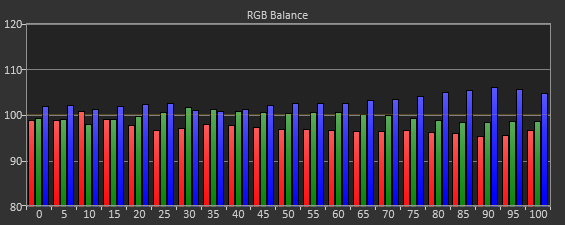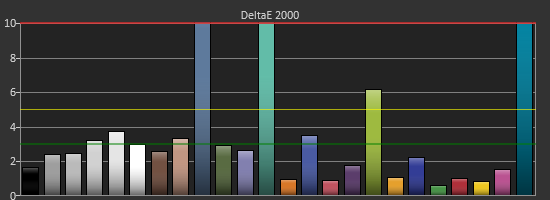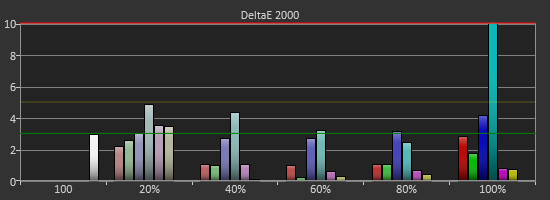LG 29EA93 Ultrawide Display - Rev. 1.09
by Chris Heinonen on December 11, 2012 1:20 AM ESTLG 29EA93—AV Use and Calibration
The LG 29EA93 is designed to work as both a PC display and a display for movies, games, and TV. With a pair of HDMI inputs to go with the VGA, DisplayPort, and DVI inputs, you can easily hook up a game system, Blu-ray player, DVR, or other AV device to watch on it. The LG 29EA93 also has internal speakers for your audio and can be switched between AV and PC mode in the menus, which should ideally switch between video and PC levels for that input.
It also features a 2-axis, 6-point CMS to calibrate primary and secondary colors, as well as a user adjustable color temperature to get the white point correct. We've seen this on a couple other displays that have come around, but it is still very uncommon on a PC monitor compared to a TV. This is also very similar to the CMS that LG puts into their consumer televisions, which I’ve used and calibrated to good results before.
The LG 29EA93 also features four preset modes: Cinema, Standard, Vivid 1, and Vivid 2. Once those are selected your only adjustments are for brightness, with contrast, sharpness, and other controls being locked out. Since most users will likely select one of these, I did a full set of measurements on all of them to see how they perform relative to each other.
| Cinema | Standard | Vivid 1 | Vivid 2 | |
| Grayscale dE 2000 | 6.459 | 4.1175 | 9.0987 | 10.5897 |
| CCT Avg (K) | 5585 | 7092 | 8258 | 9484 |
| Primary and Secondary Color dE2000 | 7.4409 | 7.37 | 13.4953 | 13.9677 |
| Saturations dE2000 | 5.4043 | 6.4582 | 9.6899 | 10.7163 |
| Gretag Macbeth dE2000 | 5.8488 | 6.1185 | 9.8674 | 10.763 |
| Gamma | 2.0066 | 1.9593 | 1.9131 | 1.9207 |
Looking at the data, the most accurate modes are Cinema and Standard, with the Vivid modes being really blue in temperature and having huge errors in color and grayscale. The Cinema mode has a bit of a red push to it in the grayscale, whereas the Standard mode is a slight bit blue but is more accurate in comparison to Cinema. On colors, Standard can’t quite compete with Cinema, even with the red push that Cinema adds to everything. Both are close overall, but Cinema is a bit more accurate. I also just preferred the look of Cinema myself, as the warm, reddish tint is more pleasing to me than the colder blue tint on Standard, but others might feel differently. With Black and White content I’d certainly choose Standard, but with a normal film I’d likely move to Cinema.
One drawback that both modes have is posterization or color clipping at the top of the spectrum. On the Disney World of Wonder calibration disc, clouds that roll across the sky at the title screen are clearly blocky and wrong on both Cinema and Standard modes. However the Vivid modes do not suffer from this posterization at the top of the spectrum. On a typical TV you would try to correct this by reducing the contrast to see if you are clipping a color, but this can’t be done on the LG 29EA93.
Watching some film content it isn’t as noticeable, but if you watch a very highlight filled film like Art of Flight, you might really not want to watch it on Cinema or Standard. So none of these do a perfect job with color or grayscale, and the ones that are best in those areas have an issue with posterization on highlights. To see if I can fix this I ran a calibration using CalMAN 5, an i1Pro spectrometer, and a Quantum Data 882 as a pattern generator.
The first thing to adjust is the grayscale that only offers a single point instead of the more common 2- or 10-point options. When I attempted to adjust this point, no matter what I did I found the results were the same. I could be looking at 50% or 100% stimulus values, and moving Blue from 0 to 100 affects nothing at all. With the User mode adjustments having no effect, I chose the Warm preset as it was closest to D65. For gamma none of the choices led to the linear 2.2 gamma that I want, and the one with the best average Gamma was Gamma 2.

Adjusting the colors with the CMS is not easy at all. The basic controls for color and tint are missing, and there are only saturation and hue controls for each individual color. I made a first run using 75% stimulus and 100% saturation and came out with results that I didn’t like, so I did another pass at 75% stimulus and 75% saturation that was better and that I will comment on.
The individual color controls are very touchy but also interact with each other and other colors. Cyan is the worst color by far at the start but I could correct it using its controls to where it had a dE2000 of less than 1. However, adjusting the controls for Cyan causes the Green primary to shift heavily and need more adjustment, and fixing Green leads to Cyan being off again. Below you see the best I could manage, where most colors are OK but Cyan is horrible as is any color near it.


Red, Yellow and Magenta are all very well behaved and controlled, and Blue is good except for a lack of saturation, but Blue is the least important to get right. Even after making multiple passes with Cyan and Green I could only get them so accurate due to the interaction of the controls and so I quit at a certain point. Measurements of Saturations and the Gretag Macbeth Color Checker show that Red, Yellow, Magenta and Blue all perform decently, but Cyan is horrible and Green is also bad. The saturations are way off, and points in the color checker that combine them are truly horrible with dE2000 values well over 10. As nice as it is for LG to include a CMS in the 29EA93, it is not functional and I wouldn’t use it if I had it.


Viewing the calibrated image only proved the point. Watching Drive on Blu-ray, using an Oppo BDP-93 as a source and having it do the Anamorphic Stretch (to properly use the 21:9 screen area), the screen is filled with posterization and blobs of color that are totally incorrect. Detail is lost and it is a really bad image, no matter what the charts say. Going back to Cinema or Standard produces a far superior image that I was happy to watch and enjoy for a while longer. If you are using the 29EA93 as a non-PC display as well, stick to a preset like Cinema or Standard, and don’t bother with the CMS as it will only cause frustration and lead to a worse image.
One more nit-pick I have about the LG 29EA93 when used as a video display is the lack of a remote control. With a video display I want to be able to change inputs and adjust volume without having to be at the display, but there is no way to do that on the 29EA93. Providing some way to control it remotely, either with a remote or via an iOS or Android App, would make for a big improvement in its use as a dual-purpose display.












90 Comments
View All Comments
Olaf van der Spek - Tuesday, December 11, 2012 - link
Why don't you ask LG (or Dell) for a detailed technical explanation for this input lag? I tried but failed. :(
If the input resolution is right the scaler should be bypassed and if the resolution isn't right scaling still shouldn't take more than 5 ms.
cheinonen - Tuesday, December 11, 2012 - link
I did talk to LG in depth about it and the concerns that came up during testing. They seemed receptive to the idea in the future that a mode to bypass all of the processing for displaying the information faster for games about be useful. I have no idea if anything will come of it, but at least they understand the issue from gamers and what they want.From all the displays tested, the lag seems to be a combination of multiple inputs, screen adjustments (such as the CMS here), and then scaling the image. The scaler itself might play little to no role in it, and it can all be the inputs and the image adjustments that cause the issue, but without being able to test the individual panel with different components, it would be hard to determine.
Olaf van der Spek - Tuesday, December 11, 2012 - link
The HP has multiple inputs too and doesn't suffer from input lag.Color adjustments should be possible without latency. I guess LG couldn't come up with a technical explanation for the lag?
rwei - Tuesday, December 11, 2012 - link
Was kind of confusing for a few secondsaranyagag - Tuesday, December 11, 2012 - link
recently (3 months) bought an asus PA246Q, wide gamut(Adobe RGB), 16:10 screen, for professional use and at the same time got an Lg 32" as a present. the ergonomics of the asus screen have to be experienced, as have the colours( in colour aware apps-- even Firefox). Even videos are be good to go through as the media player control do not hide the material.I think you should consider reviewing it, as it offers tremendous VALUE FOR MONEY.
The only thing is that I have no idea how it will work for use as a home cinema use-- because that is NOT what I got it for.
aranyagag - Tuesday, December 11, 2012 - link
Sorryhttp://www.anandtech.com/show/6032/asus-pa246q-24-...
Kevin G - Tuesday, December 11, 2012 - link
From the article:"Of course there aren’t any 21:9 CRT displays around that I’m aware of so once again this is tested at 1920x1080 resolution using SMTT and the 1:1 mapping selected in the menu."
Is there any way to test it at its native 2560 x 1080 resolution? I can imagine the scaler for this displaying being a bit unique considering its aspect ration and relatively high resolution. The scaler isn't altering the image resolution but it does have to add the black bars on the side of the image. It is at the very least doing something and running the display at the native resolution would be able to by pass it resulting in lower lag. The lack of 21:9 CRT's would be a problem but couldn't the display be tested against itself? IE two side by side. Getting a solid number would be difficult but observing a significantly lower input lag should be possible.
I'd also like to see a review of the Dell U2913wm display. it should use the same panel and will likely get similar results (which aren't bad). The main difference appears to be that the Dell supports DisplayPort chaining so there would be a case for testing more than one. :)
cheinonen - Tuesday, December 11, 2012 - link
The testing was done at 1920x1080 and the LG doesn't scale that image, it is centered in the display which in theory should introduce no lag. The only analog displays that I'm aware of that can do 2560x1080 at 60Hz are high end CRT projectors with 9" CRT guns. While still available used, they're still thousands of dollars and a couple hundred pounds to install, so I wouldn't count on seeing one soon for testing a display like this.nathanddrews - Wednesday, December 12, 2012 - link
FWIW, my FW900 can push 2560x1600@60Hz with some driver patching and custom resolution tweaks. I've heard of people getting up to 70Hz, but that requires exceeding some boundaries I'm not comfortable with. I rarely go above 1920x1200 with my daily work and gaming, but that's only because those super high resolutions have such low refresh rates and they are too difficult to resolve - making it rather moot.I'll see if I can match the native resolution of this LG.
malkion - Tuesday, December 11, 2012 - link
I tend to dislike seeing tech reviewers get personal feelings involved, or how their opinions of any technology regarding future outlooks are, however, I will never mind it, the review itself being more important.The bottom line for me is always to keep new technology affordable, or I will have to wait a few years until it does.
For any particular monitor that's not a big screen, I'll only pay around $300 tops for it. You can easily guess this fits me into the current sweet spot to buy 27" LCD monitors at the moment, right? For desktop, the is very nice.
As far as the 21:9, 16:10, 16:9 debate, I actually want them all. More variety for end users. And the popular opinion vs unpopular opinion state-side isn't all that bad either (not that I actually lean towards the 'in the box' mindset)
I never did like the VCR vs Beta debate, nor do I like industry standards too much over competing tech such as Blu-Ray vs HDDVD or HDMI vs Display Port. I can live with dual players instead. Haha. Or Monitors that sport both types of connectors. It doesn't cost that much for either one to be printed on disc or to include both kinds of connectors. Ok, signing off.